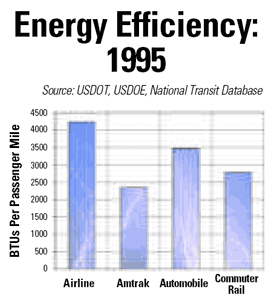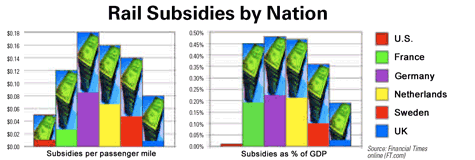The U.S. needs reliable passenger trains to complement our highways and airlines — not more corporate handouts
In January, the Amtrak Reform Council (ARC) reported that Amtrak had failed to meet the deadline for self-sufficiency that Congress gave them in 1997, and ARC unveiled their plan to privatize our passenger rails.
Their "cure" for America's ailing intercity passenger rail system is worse than the disease as diagnosed by Congress: poor service caused by lack of competition and unprofitability, which leads to government subsidies.
ARC's plan calls for selling "exclusive rights" to each of Amtrak's routes to a private company, which would be eligible for government subsidies for operating losses and capital improvements. Since "exclusive rights" means no competition, and because government subsidies will continue, one has to ask what the plan accomplishes.
Of course, the answer should be obvious -- it provides another way for Congress to move money from taxpayers' pockets onto the bottom lines of private companies. We should have expected no less. ARC was created in 1997 by the same pro-privatization and deregulation Congress that made Enron's financial shenanigans and the California power shortages possible.
How We Got This Far
ARC's mission was a canard from the start. Congress gave them two directives: 1) Wean Amtrak from government subsidies; 2) If that fails, create a plan to privatize passenger rail.
Everyone knew the first is simply not feasible. Amtrak was created in 1971 because private railroads asked Congress to take over passenger rail service, which was no longer profitable. Amtrak had no chance of succeeding where private companies had failed.
After all, passenger trains did not die a market-driven death. They had been losing customers since the 1930s, when a consortium of General Motors, Firestone, Standard Oil, and others began buying up popular electric street trolleys in U.S. cities, shutting them down, and lobbying for highways at the expense of rails. As the air travel industry developed, they, too, began drawing customers away from trains and lobbying Congress to build airports.
Congress responded to those lobbying efforts by heavily subsidizing the automobile and airline industries, while giving nothing to railroads.
Automobile companies do not build highways and bridges. The government does. Airline companies don't build airports. The government does. Yet Congress wants Amtrak to pay for track and all capital improvements without government help.
Both airlines and highways have dedicated revenue streams that pay for capital improvements. Amtrak must beg for table scraps, as their CEO has put it.
The $15 billion airline bailout of last year attracted a lot of attention, but Congress has spent 70 times as much money on airports and highways as on Amtrak over the past 30 years with little mention in the media.
Last year alone Congress gave airports $12 billion and highways another $33 billion without a peep from congressional watchdogs. Yet the $1.1 billion subsidy Amtrak needed was enough reason — in the minds of many — to shut them down.
Congress is missing the boat on this important issue. Americans have consistently reported in polls that they want intercity passenger trains. Since Sept. 11, that interest has been growing.
Passengers understand what Congress does not: a truly efficient intercity transportation system uses air, highway, and rail to their fullest extent.
That isn't possible when passenger trains serve only a handful of cities.
That isn't possible when most of our trains must operate at slower speeds because the tracks and equipment are out of date.
Congress's Antipathy Toward Rails Is Not Logical
Why Congress shortchanges rail transportation is a mystery to many. Intercity passenger trains have distinct advantages over cars and airplanes for many situations.
For trips under 300 miles, they offer the fastest travel — even before the post-Sept. 11 extra security went into effect. In the U.S., half of all airline trips are under 300 miles. A viable rail system would make an enormous difference in productivity and comfort.

Trains are also the most fuel-efficient way to move people long distances, requiring only half as much fuel per passenger mile as airplanes. Reducing the nation's fuel use not only makes us less dependent on foreign oil, but it also reduces emissions of pollutants.
And there's another point that has only recently become important. No terrorist can hijack a passenger train and drive it into a skyscraper or the White House. Or into a nuclear power plant. Trains are not immune to terrorist attacks, but they do not lend themselves to being used as weapons of mass destruction as airplanes do.
But we can't enjoy the advantages rail travel offers unless we improve our rail system. Faster trains will attract more customers, but upgrading tracks so they can accommodate modern, high-speed trains like the 150-mph Acela, which Amtrak has recently introduced on the Northeast Corridor, costs about $5 million a mile.
Upgrading a majority of Amtrak's routes is not feasible as long as Congress insists on making Amtrak beg for table scraps, as they have been doing for the past 30 years. Amtrak needs its own guaranteed revenue stream, like airports and highways enjoy.
Congress's Antipathy Toward Rails Is Not Logical, Continued
A few members of Congress are waking up to the need for passenger rail. As Sen. Ernest Hollings (D-S.C.) recently put it, Sept. 11 "not only proved that Amtrak works, but that Amtrak is a critical part of our transportation infrastructure." Rep. Don Young (R-Alaska) said, "It is time for the United States to make high-speed passenger rail a transportation priority." Hollings was asking for $38 billion. Young for $71 billion over the next ten years to improve both passenger and freight trains.
That sounds like a lot, but even these proposals fall short of what is needed — a full overhaul, like what the United Kingdom announced in January. Admitting that their privatization scheme (very similar to ARC's) had failed after only five years, UK Transportation Secretary Stephen Byers announced a plan to spend $100 billion over the next ten years to improve Britain's passenger rail service.
The UK's population is about one-fourth of ours — under 60 million. But imagine the outcry if Amtrak asked for a commitment of $100 billion, even if it is spread over ten years. That is nearly five times what Amtrak has received in its entire 30-year history.
But it is not out of line with what other European nations are spending. Germany spends 13 times what we do; France spends eight times as much. Even the Netherlands, with a population one-sixteenth of ours, spends more than twice as much as we do on railroad subsidies.
Our public spending per-passenger mile is less than half what France spends and not even one-third of what Germany and the Netherlands spend.
And when passenger rail subsidies are considered as a percentage of the gross domestic product (GDP), America's neglect of railroad travel becomes painfully apparent.
The U.S. spends about one-hundredth of one percent of our GDP on passenger rail subsidies. If we were to increase our spending to match Germany's, the U.S. would be putting aside more than $30 billion a year for Amtrak.

Spending at that level may not be warranted, given America's geography. But as airports and highways become increasingly clogged, U.S. travelers deserve to have an efficient, reliable alternative for intercity travel.
What Congress Should Do
Congress should ignore ARC's recommendation and begin an aggressive program to rebuild our passenger rail service.
To do that, Congress must establish a dedicated revenue stream and a Rail Trust Fund, like the trust funds for highways and aviation.
They should also allow states to spend some of their flexible surface transportation funds on intercity passenger rail. At present, these funds can be used for most other transportation, including hiker/bike trails. Why not passenger trains?
We need high-speed trains not just in the Northeast Corridor, but in all of Amtrak's major corridors. High-speed rail is nothing new. France's 200-mph TGV carried its first passengers in 1981. Yet Amtrak's only high-speed train, the Acela, barely reaches 150 mph. Trains on many routes that are called "high-speed" rarely move faster than automobiles.
Getting Congress to take passenger rail seriously will not be easy. Airlines and automobile manufacturers have powerful lobbies, and they view every train passenger as a lost customer.
We must make Congress realize that reliable, efficient passenger rail travel is just as essential for our nation's future as the Interstate highway system and airports. These systems were not built by private enterprise, but by the government. We can't expect private enterprise alone to do everything needed to provide intercity passenger rail service, either.






